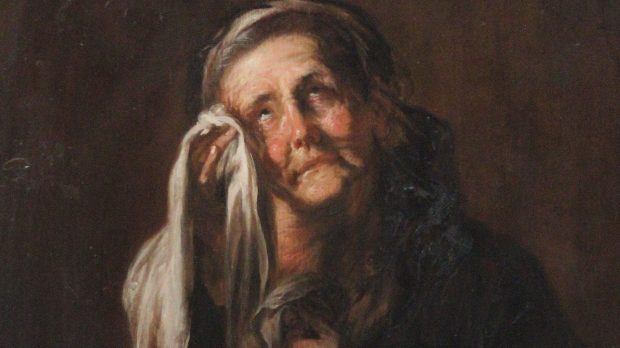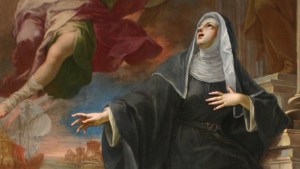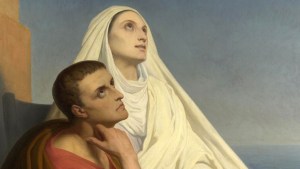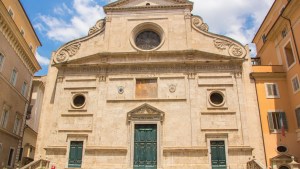For over 1500 years Saint Augustine’s Confessions has been a source of inspiration to Christians throughout the world. Filled with rich philosophical, theological, and psychological insight, Augustine’s penetrating insights on the human condition and the search for truth are timeless. Of the many extraordinary stories and reflections presented by Augustine, one of the most tender is his portrayal of his relationship with Saint Monica, his mother.
Below are presented four moving keys to better understand Saint Augustine and his relationship with Monica.
The Church, mother of all
Saint Augustine was born to a devout Christian mother, Monica, and a non-Christian father, Patricius (although Patricius would be baptized before his death). As a baby, Augustine was bless with the sign of the cross and salt was placed upon his lips. Although infant baptism was common in North Africa at the time, Augustine’s baptism was deferred. Reflecting back, years later, Augustine would write,
“You saw, my God, for you were already my keeper, with what effort of mind and with what faith I entreated the mercy of my own mother and of the Church, the mother of us all, for the baptism of your Christ, my God and Lord.” (Book I, Chapter 11)
For Augustine, Monica was a custodian, a guardian. Her devotion greatly impacted him. Her piety was a tremendously important factor in his own journey to faith. Owing to his relationship with Monica, Augustine is easily able to see the Church is our Mother. She is guardian of faith and witness to the grace of Christ.
Monica’s tears
At the time, Saint Augustine was part of the Manichean sect. As such he did adhere to the practice or beliefs of the Church. His separation from the Church grieved Monica; she desperately prayed for his return.
“‘You put forth your hand from on high, and you drew my soul out of that pit of darkness, when before you my mother, your faithful servant, wept more for me than mothers weep over their children’s dead bodies. By that spirit of faith which she had from you, she saw my death, and you graciously heard her, O Lord. Graciously you hear her, and you did not despise her tears when they flowed down from her eyes and watered the earth beneath, in whatsoever place she prayed.” (Book III, Chapter 11)
Monica’s tears became a font of life for Augustine. Her intercession, her constant beseeching of the throne of heaven, is a vehicle for grace for Augustine. Monica’s warnings and reprimands, her laments for Augustine’s deviant life, fall upon his deaf ears. And yet Monica remains faithful, never giving in to despair, constantly continuing to pray and hope for Augustine’s conversion.
Monica’s dream
Saint Monica had a dream that she believed was a direct message from God. It was a source of consolation to her. But given the eventual path of Augustine’s life, the dream was prophetic.
“She saw herself standing upon a certain wooden rule, and coming towards her a young man, splendid, joyful, and smiling upon her, although she grieved and was crushed with grief. When he asked her the reasons for her sorrow and her daily tears—he asked, as is the custom, not for the sake of learning but of teaching—she replied that she lamented my perdition. The he bade her rest secure, and instructed her that she should attend and see that where she was, there was I also. And when she looked there she saw me standing on the same rule.” (Book III, Chapter 11)
In the dream, the rule is a sort of measuring rod. It represents the “rule” of sound teaching or upright faith. For Monica to see Augustine on the rule, standing with her, meant that he would eventually return to the Church and embrace Monica’s faith.
The vision at Ostia
Shortly before Saint Monica died—Augustine having been baptized and converted from Manichaeism to Christianity—Monica and Augustine shared a mystical experience at the port city of Ostia. Sitting by a window the two talked and talked of the things of God.
“We proceeded step by step through all bodily things up to that heaven whence shine the sun and the moon and the stars down upon the earth. We ascended higher yet by means of inward thought and discourse and admiration of your works, and we came up to our own mind. We transcended them, so that we attained to the region of abundance that never fails, in which you feed Israel forever upon the food of truth, and where life is that Wisdom by which all these things are made, both which have been and which are to be.” (Book IX, Chapter 10).
Delighting in their conversation, and experiencing yet more consolation still from the nature of their vision, Monica expresses her joy. The one thing she asked for, the conversion of Augustine, had come to pass. With such peace in her heart, she is ready to die, asking only for Augustine to remember her at the altar of the Lord.





